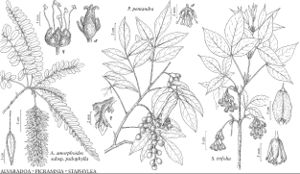Picramnia
Prodr., 2, 27. 1788.
| Taxon | Illustrator ⠉ | |
|---|---|---|
 | Picramnia pentandra Alvaradoa amorphoides subsp. psilophylla Staphylea trifolia | Marjorie C. Leggitt Marjorie C. Leggitt Marjorie C. Leggitt |
Shrubs or trees, rarely subshrubs, (2–) 15–80 (–220) dm. Leaves imparipinnate [paripinnate (with 1 of distal pair of leaflets oriented terminally)]; leaflets [1–] 5–11 [–33], alternate or subopposite, ovate to elliptic, 14–300 × 8–160 mm, base of terminal usually symmetric, of lateral ones usually oblique. Inflorescences terminal or axillary, rarely cauliflorous, [racemes or simple] compound thyrses. Flowers: sepals 5; petals 5; staminate flowers: anthers usually with enlarged connective, thecae parallel; pistils reduced to cylindric or lobed pistillodia or tufts of hairs; pistillate flowers: stamens reduced to staminodia or 0; pistils 2-carpellate or 3-carpellate, all carpels potentially fertile. Fruits berries; sepals persistent. Seeds 1–3.
Distribution
Fla., Mexico, West Indies, Central America, South America
Discussion
Species 43 (1 in the flora).
Picramnia is a neotropical genus, extending from Florida (Miami-Dade County) and Mexico to subtropical South America (northern Argentina and southern Brazil); members of the genus are found primarily in moist and semideciduous forests.
Selected References
None.
Lower Taxa
"dm" is not declared as a valid unit of measurement for this property.